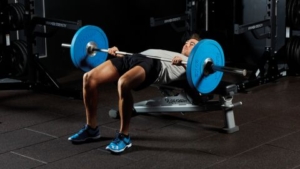
Having strong glutes are essential for gym training and any sport. They assist in a number of activities and will improve your overall performance.
A great movement to start with is a glute bridge. Once you have mastered these, you can move on to a hip thrust. This involves placing your upper back against an elevated surface like a bench, and then extending, or straightening, your hips to isolate your glutes. Most of the time, you do it with a barbell or dumbbell on your lap.
For the best glute results, zero in on your form and avoid these 4 workout-wrecking hip thrust mistakes.
Moving Too Quickly
Moving at a lightning pace doesn’t help you reap all the glute benefits this exercise has to offer.
Instead, it both reduces the amount of time your glutes are under tension (something you need to grow muscle) and increases the chances you’re using momentum, not your muscles, to move the weight.
Slow down your reps. Think: “3, 1, 2.” Raise the weight over the count of three seconds. Pause for one more. Then lower the weight over the count of two.
Letting Your Knees Cave In
When people do hip thrusts, they rarely think about their knees. The result: Their glutes kind of phone it in.
Keeping your knees in place is critical to really activating and building your backside. You want your knees to stay evenly apart through the entire range of motion. They should exactly as far apart as your feet are from each other.
You can wrap a light resistance band around your thighs just above your knees. This gives you a physical reminder of where your knees should be — and helps you really feel your glutes working.
Putting Your Feet in the Wrong Position
To really hone in on your glutes, you need to pay attention to where you set your feet.
You don’t want to place your feet too close to your glutes because then the hip thrust can become a quad-dominant exercise, But when your heels are too far [from your hips], your hamstrings can take over.
To isolate their glutes, most people should set up so that, when their hips are fully raised, their shins are completely vertical and perpendicular to the floor.
Test different foot placements until you find the spot that helps you move the weight with your glutes as much as possible.If you feel your hamstrings or quad muscles working hard, you probably need to readjust your hip thrust form. Your glutes should always feel like they’re working the hardest.
Arching Your Back
One of the most common hip thrust mistakes involves over-arching your lower back. Throughout the entire exercise, your trunk should be as stiff as a board. Not only does a braced core help strengthen your glutes, it also helps keep any extra stress out of your lower back.
One big reason people arch their back: They throw their head back against (or even below) the bench with each rep. Letting your head fall back makes it easy to accidentally curve your neck. And when you arch the top of your spine, the rest tends to follow.
Throughout the entire exercise, keep your eyes focused on the wall in front of you and your chin tucked to your chest. Resist the urge to look up at the ceiling.
Then, as you lower the weight, keep your core braced. Focus on pivoting your back against the bench, rather than wrapping around it.
